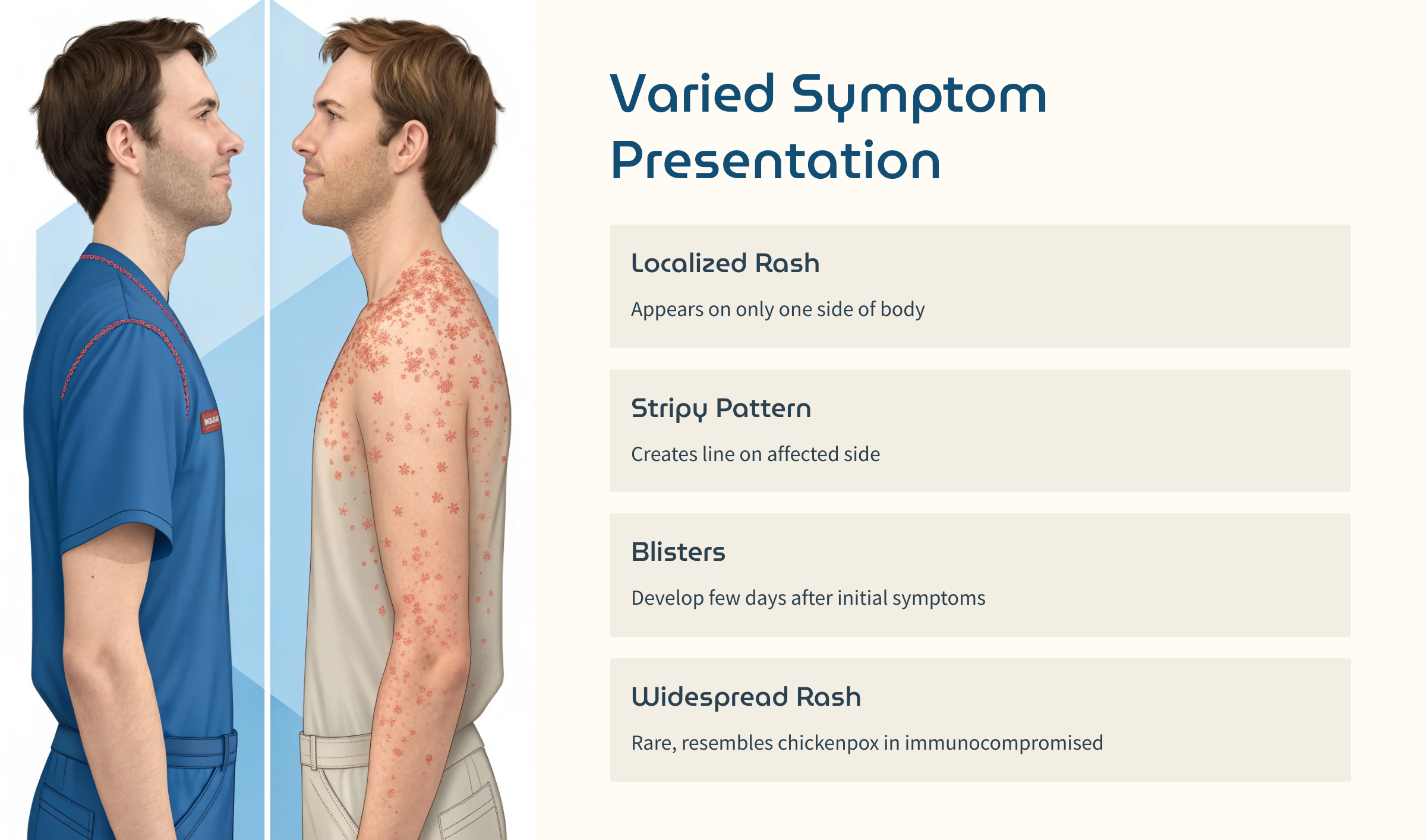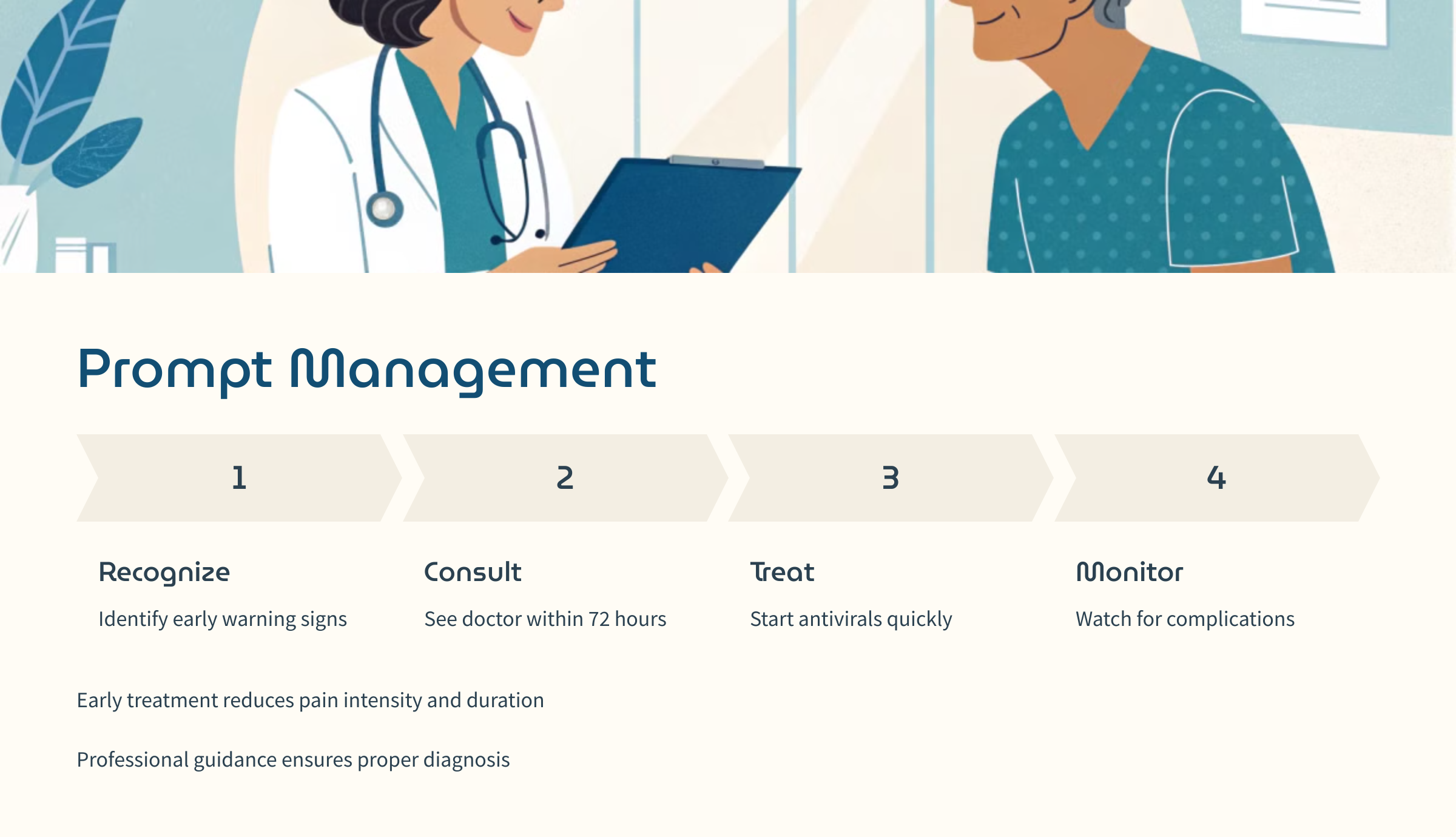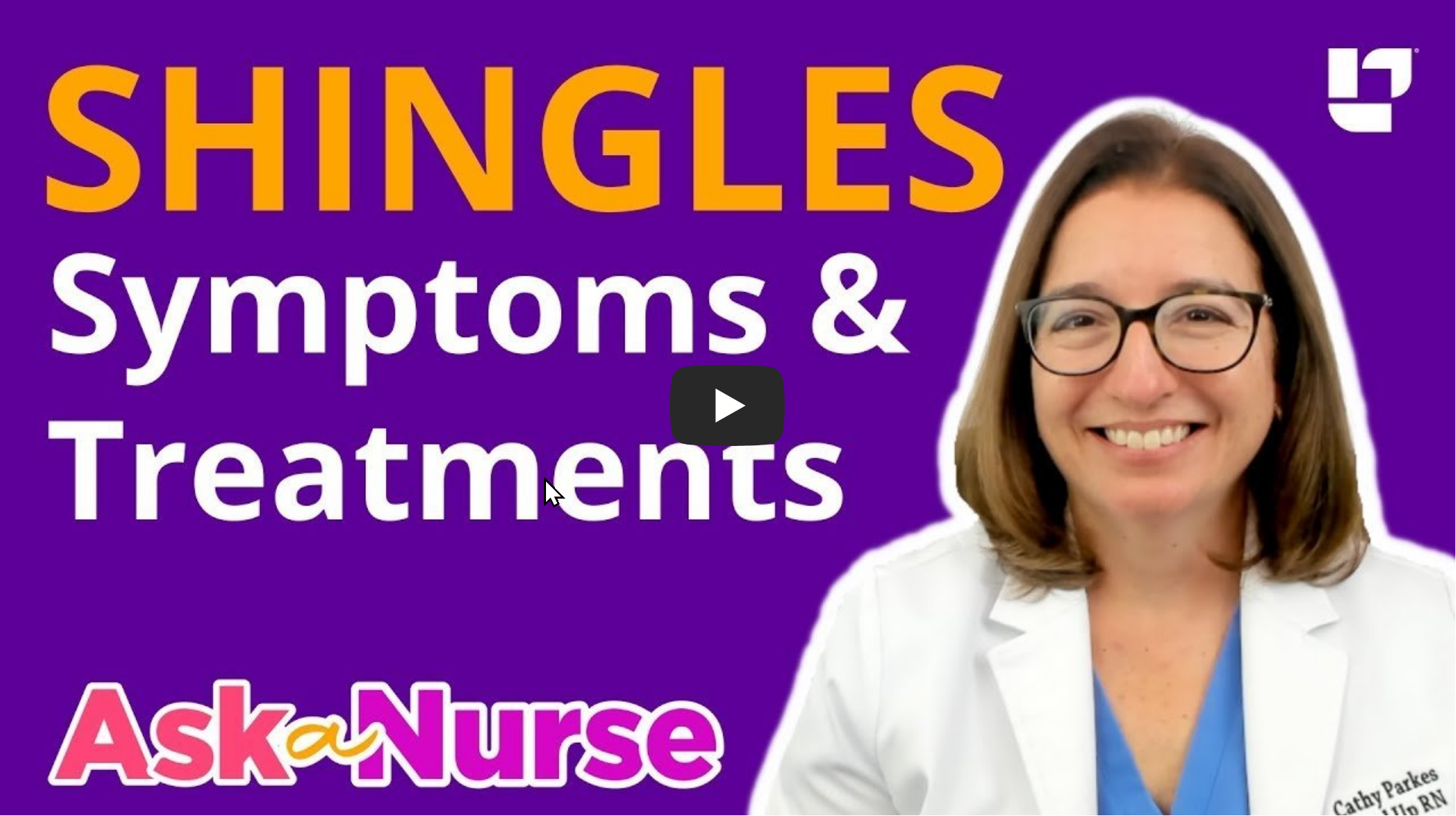Complete Guide to Early Shingles Symptoms Self Check with 7 Methods
Recognizing Early Signs
Spotting the early hints of shingles can make life a lot easier, trust me, as it helps dodge those annoying complications. The journey for me kicked off with some unwelcome guests - pain, itching, and that pins-and-needles tingling. Fever decided to crash the party later on.

Pain, Itching, Tingling
Shingles gave me a little nudge by first sending some pain, burning, numbness, or tingling to one part of my body, usually choosing a single side. This nagging feeling would happen a few days before any rash made its dramatic entrance. For me, these sensations were like a little alarm bell, hinting that shingles might be on the horizon.
Here's a quick list of what you might deal with:
SymptomDescription
| Pain | A fiery or sharp ouch in a specific spot |
| Itching | That unbearable need to scratch in the same area |
| Tingling | Feels like a bunch of ants doing the cha-cha |
If I picked up on these signs, it was like my body's way of saying "Heads up!", so I'd jump into action and get medical advice.

Fever Preceding Rash
Apart from the local annoyances, a mild fever could precede the rash's debut. It's like a tap on the shoulder from my immune system saying, "Hey, something's cooking." So, when fever cozied up with pain or tingling, it was as if shingles might just crash my party.
The early days might also toss in a headache, chills, and a stomach that's not too happy. Recognizing this mix can be a helpful clue in sorting shingles from all the other stuff. Catching onto my symptoms early could stave off the big bad, like the lingering post-shingles pain known as postherpetic neuralgia (CDC).
Keeping an eye out for itching as a signal helped me steer clear of unnecessary worry. And if ever in doubt, snagging a pro's take on it can save the day. Experts can tease apart the difference between shingles and other pesky issues, whether it's distinguishing shingles from chickenpox or telling if I'm dealing with an allergic reaction instead.
Understanding Shingles Rash
Alright, let's tackle the fun world of shingles! Spotting a shingles rash early is like having a superpower helps me know what's up with my body. Here's my checklist for when I think shingles might be knocking on my door.

Rash Appearance
So, shingles likes to play it cool by showing up as a strip of blisters either on one side of my chest, around an eye, or chilling on one side of my face or neck. Picture little fluid-filled balloons that eventually pop and form a crust. The whole healing gig takes about 2 to 4 weeks sort of like nature's way of saying "take it easy" (Mayo Clinic).
Rash CharacteristicsDescription
| Blistering | These babies are full of fluid and burst open |
| Healing Time | Around two to four weeks, give or take |
| Typical Locations | Side of the chest, face, or neck |
Occasionally, the rash prefers to go big, looking like a chickenpox ensemble, but that's rare and usually a party for those with a less-than-peppy immune system (CDC).
Symmetrical Distribution
Good ol' shingles usually takes the scenic route along a nerve path, flaunting a line or band. The varicella-zoster virus loves a specific road trip down nerve highways, favoring one side of my body. Imagine a line going either left or right down my chest or face (Cleveland Clinic).
If a rash decides to vibe in this pattern, and I’m feeling that early pain or itch like an uninvited guest, it might be shingles dropping by. For more tea on those sneaky signs like itching, or distinguishing your chickenpox from your shingles, check out this guide.
Spotting those rash features early can seriously save me a lot of hassle. Like, if the rash starts looking like my allergies are throwing a fit instead, it’s worth diving into this handy tip sheet because figuring out if it's shingles or an allergic drama can change everything!

Long-Term Complications
When dealing with shingles, it’s important for me to grasp potential long-term problems so I can handle recovery in the best way possible.
Postherpetic Neuralgia
Postherpetic neuralgia (PHN) is that nasty lingering nerve pain after shingles. I found out, to my dismay, that this condition is a common issue, hanging around even when the rash disappears. The CDC says this pain can bug me for months or even years, putting a real damper on my day-to-day activities.
Some data suggests that about 10-18% of folks who've had shingles get hit with PHN. Aging raises the odds of getting this annoying condition. Here's how age bumps up the PHN risk:
Age GroupPercentage at Risk of PHN
| Under 50 years | 10% |
| 50 years and over | 13% |
| 70 years and over | 75% |
Jumping on shingles treatment quickly might just cut down the chance of PHN. Anybody who's had shingles should keep an eye on any lingering pain after the rash is gone, says Medical News Today.
Risk Factors
A few things might hike up my chances of getting shingles complications, especially postherpetic neuralgia:
- Age: Like I mentioned, those golden years bring a bigger risk, especially past 70.
- Timing of Treatment: Dragging your feet on treatment might spell more trouble.
- Severity of Initial Symptoms: Worse starting pain and rash might mean more long-term issues (Mayo Clinic).
- Weakened Immune System: If your immune system's not up to snuff, you could be in for a rougher ride with lingering symptoms and issues.
Learning about these risk factors keeps me on my toes about my health and what steps to take as I get better. If you're starting to see shingles signs early, catching early shingles warning signs itching or spotting any one-sided rash shingles identification is key to dodging those long-lasting problems.

Varied Presentation of Symptoms
Figuring out how shingles show up is key for spotting symptoms early and handling the bugger without too much hassle. In my bout with shingles, I found out that it can act all sorts of differently depending on who's got it.
Different Patterns
The first signs I had were like a sneak peek into what was coming. Soon, a rash decided to crash my party, popping up on just one side of my bod, mostly around my ribs. But let me tell ya, this rash can be sneaky and sometimes likes to hit you on one side of the face, too. Here's the lowdown on what I noticed:
Symptom PatternWhat's Going On
| Localized Rash | Shows itself on only one side of the body. |
| Stripy Rash | Creates a neat little line on the affected side. |
| Blisters | The rash may unleash these little bubbles a few days later. |
It’s good to remember that the rash usually pops up not long after you start feeling things like pain or tingling (according to NHS). Spotting these signs early can really help in managing the shingles (early shingles symptoms self-check).
Rare Widespread Rash
Every now and then, I learned, the rash throws a curveball. Especially in folks with weaker immune systems, this pesky rash can spread out and look a lot like a chickenpox breakout, which is on the rare side (CDC). This can really throw you off, so it's good to know the differences between shingles and chickenpox.
If I found suspicious signs like these, it made me more careful to rule out other stuff. For instance, if I spotted a one-sided rash shingles identification along with certain other signals, I knew to check in with a doc.
Take a good look at that rash early on, especially if it seems a bit too much like differentiating chickenpox from shingles, 'cause treatment can take a different route. Figuring out these differences not only made me feel more in control but also helped avoid some nasty bumps down the road with the disease itself.
Staying in the know and keeping a lookout can really make a big impact on managing shingles and getting back to feeling good sooner rather than later.

Impact on Immune System
Weakened Immune Response
Discovering that shingles is knocking on my door makes me think about what’s happening with my immune system. This sneaky varicella-zoster virusthe same troublemaker behind chickenpoxdecides to pop back up just when my defenses are down. If I’m dealing with a shaky immune system, especially from being older, going through chemo, or managing autoimmune issues, the risk of shingles cramping my style is higher. Serious complications can follow, including those nasty rashes that stick around like a bad aftertaste, messing with my everyday life (CDC).
When my immune army isn't on its A-game, controlling the virus becomes a marathon instead of a sprint. That means more pain and a slow path to feeling better. I've got to stay tuned to my body and watch for any changes. Here’s a little cheat sheet for what can throw my immune system off-balance:
Factor Affecting ImmunityImpact
| Getting up there in years (50+) | More complications with age |
| Stress overload | Drags down immune performance |
| Medical treatments on the tough side | Cancer therapies can zap immunity |
| Autoimmune struggles | My body turns on itself |
Looking for ways to spot shingles early? Check out the section on early shingles warning signs itching for some pointers.
Importance of Medical Advice
Reaching out to a doctor when shingles makes me suspicious is a must. Acting fast can ease the symptoms and keep those nasty complications at bay. Having a chat with a healthcare provider means I can get the right meds, like antiviral drugs, that speed up recovery and take the edge off the pain.
It’s on me to make that call if I see a rash or feel the pain cranking up. Shingles isn’t just about what’s on the surface; it’s a red flag for something going on with my immune setup. By keeping tabs on symptoms and staying in touch with a pro, I’m taking a smart step.
Not sure if it’s shingles or something else? Resources like differentiating chickenpox from shingles and telling apart shingles from allergic reactions can be handy. Staying informed and cautious helps me bounce back faster and keeps my health shipshape.
Prompt Management
Getting ahead of shingles makes the ride a whole lot smoother. The moment I spot early signs, like that tell-tale tingle or persistent itch, I’m on it. It’s all about knowing when to use a lifeline and hit up a pro for advice.
Early Treatment Benefits
The quicker I jump on those early shingles signalswhether it feels like needles or just a nagging itchthe better off I am. Here’s why starting treatment sooner rather than later is my go-to game plan:
- Less Intense Drama: Getting on top of shingles at the start usually means the crash isn’t as bad. The rash might still show, but playing it smart keeps the pain and the duration in check.
- Speedier Recovery: Early bird gets the wormor in this case, healing. Antiviral meds can bring on the fast lane to recovery. That means getting back to life minus the shingle shimmy.
- Complication Dodging: Jumping on treatment quickly also lowers my odds of hanging onto post-rash pain like postherpetic neuralgiathe kind of clingy pain nobody wants.
- Pain Management: Fast action is my fast-pass to feeling a bit more human as this thing rides out. It keeps the bite of the pain and itching down a notch.
Catching onto these perks is a no-brainer for me. As soon as symptoms pop up, I’m taking them seriously and gearing up to chat with someone who wears a stethoscope.
https://youtu.be/SXuOQpI3sfs?si=7VGB-HsvYcb3TuzE
Seeking Professional Guidance
Sure, Google is great for some things, but when shingles come knocking, I don’t want to guess wrong. Here’s why ringing up a pro can save my skin (literally):
- Nail the Diagnosis: Face it, predicting a rash isn't always my strong suit. Docs, they’ve got the practice. Sometimes shingles, allergic reactions, and chickenpox seem like a mishmashcheck out guides where I can see whether I’ve got shingles versus allergies or shingles versus chickenpox.
- Get the Good Stuff: Docs have the keys to the pharmacy kingdom. They'll hook me up with antivirals fastimportant, because this stuff works best in those first 72 hours. Plus, they’ve got the scoop on what’ll help manage my ouchie factor.
- Watching for Trouble: If it’s hurting like heck or starting to spread, I’m not going to mess around. That’s when doctorly backup becomes urgent. Better safe than sorry, right?
- Specialized Game Plan: How these blisters stack up with my past and present health? Good to get a pro's advice tailored just for me.
Catching those shingles signs early and knowing what to do makes all the difference. I stack the odds in my favor with quick action and advice from someone who knows the drill. It's about being smart with my health, taking the right steps, and cruising through it all with a cool head.
Frequently Asked Questions (FAQ)
1. What are the first signs of shingles?
The earliest signs of shingles typically include pain, itching, and tingling in a localized area, often on one side of the body. These symptoms usually appear a few days before the rash emerges. Some people may also experience fever, chills, and headaches as early warning signs.
2. How can I tell if my rash is shingles?
A shingles rash often appears as a strip or band of blisters on one side of the body, following a nerve path. The blisters are fluid-filled, painful, and may eventually crust over. If the rash is one-sided and accompanied by burning pain or itching, it’s likely shingles. Consulting a doctor can confirm the diagnosis.
3. How long does a shingles rash last?
The shingles rash usually lasts 2 to 4 weeks. It starts with redness and small bumps, develops into blisters, and then scabs over. Early treatment with antiviral medication can shorten the duration and reduce complications.
4. Can shingles occur without a rash?
Yes, some people experience zoster sine herpete, a form of shingles without the rash. This condition still causes nerve pain, tingling, and burning, making diagnosis more challenging. A doctor may use tests to confirm if shingles is the cause.
5. How can I reduce my risk of long-term shingles complications?
The best way to reduce long-term complications like postherpetic neuralgia (PHN) is to start antiviral treatment within 72 hours of symptom onset. Getting the shingles vaccine (Shingrix) is also highly effective in preventing shingles and its complications, especially for those 50 years and older.





댓글